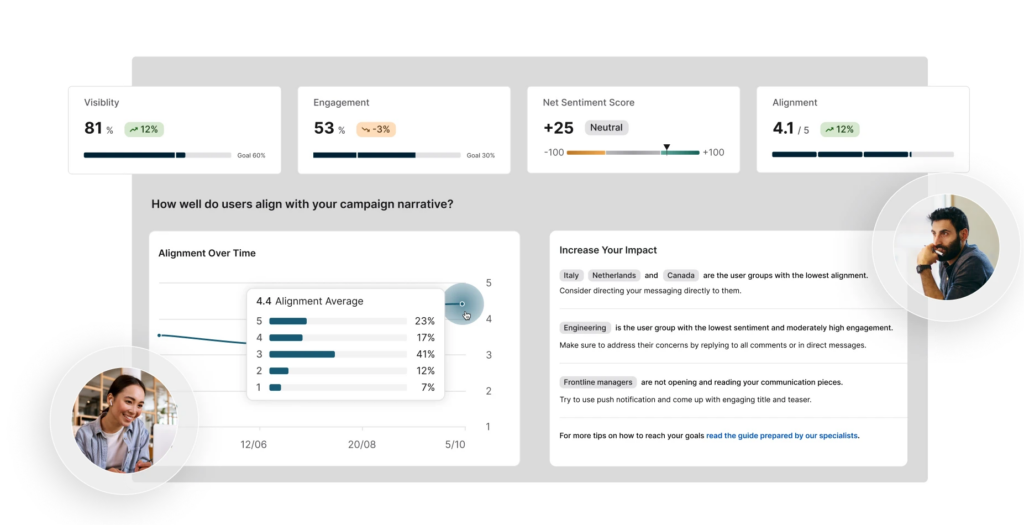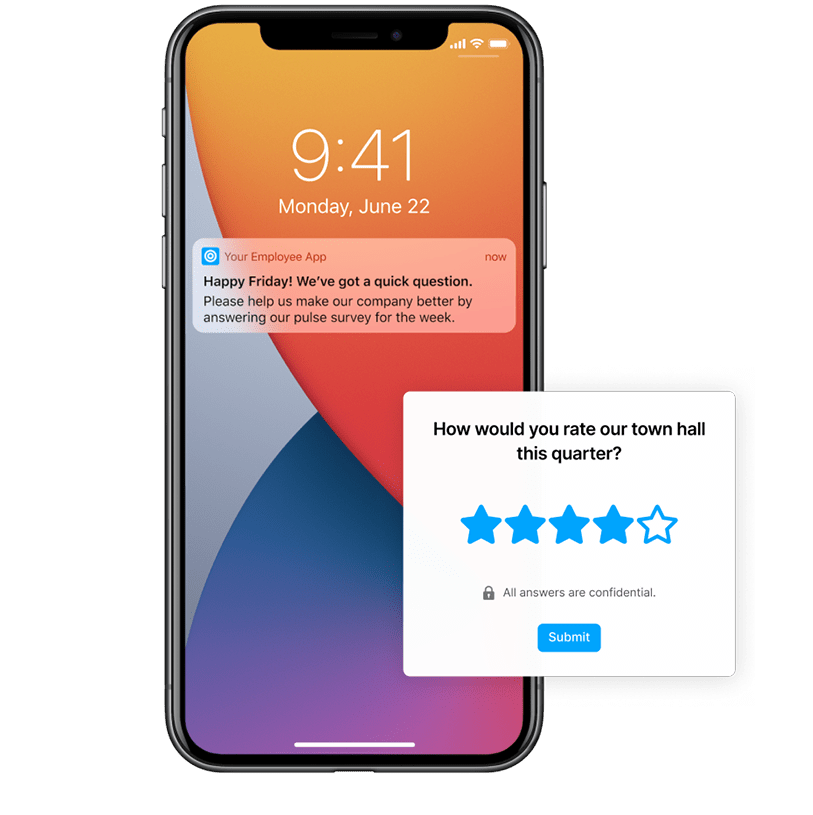How to Measure Employee Engagement: 8 Key Strategies

As all employers know, employee engagement is a key driver of organizational performance. But you can’t fix an engagement problem if you don’t know you have one. In this article, we’ll explore the different methods you can use to measure employee engagement — and ultimately improve it.
Why you should be measuring employee engagement
These days, most HR teams, internal communications professionals, and company leaders understand the benefits of employee engagement, which include improved performance, increased productivity, enhanced employee satisfaction, and even better retention rates.
But what are the benefits of measuring employee engagement? After all, tracking different engagement metrics, surveying employees, and analyzing and comparing the results over time is a lot of work. If you’re going to make that effort, you need to know it will be worth it.
The simple answer is that you can’t improve what you don’t track. Measuring employee engagement gives you a baseline against which you can compare the impact of any engagement-boosting measures you put in place. Accurately measuring employee engagement in your organization also allows you to:
Identify dips in engagement early, so you can take action before they become big problems
Pinpoint engagement issues in specific teams, departments, or locations, allowing you to identify and correct the underlying issues
Foster a culture of trust where employees know that you value their insights and experiences
Build business cases for future employee engagement initiatives by clearly demonstrating the link between actions and engagement
Key metrics to track to measure employee engagement
Employee engagement can be difficult to measure because it’s inherently intangible. Without reading your employees’ minds, it’s difficult to know how they really feel. That means that instead of trying to measure engagement directly, you need to identify key metrics that you can track, which can give you insights into employee engagement levels within your organization.
Here are some examples of concrete, tangible metrics for measuring employee engagement:
Employee satisfaction scores: Employee satisfaction is a measurement of how content employees are with their roles and the company. It might be influenced by things like work environments, team dynamics, opportunities for progression, and the work-life balance a job provides. It’s usually measured through employee satisfaction surveys.
Employee Net Promoter Scores (eNPS): A company’s Employee Net Promoter Score (eNPS) is a simple metric that’s calculated by asking employees how likely they are to recommend the company to their family and friends. Because it measures employees’ feelings about the company, it can be a valuable indicator of engagement.
Employee turnover rate: Keeping an eye on your turnover rate can help you identify problems with employee retention, which could be linked to low engagement. The reason for this is simple: employees are more likely to want to stay at an organization for longer if they’re highly engaged with their work.
Productivity metrics: Engaged employees are also likely to put more effort into their work, which could boost productivity. On the other hand, productivity often drops when employees are disengaged. Tracking metrics like output per employee, sales revenue, and project completion rates can help you understand engagement.
Absenteeism rate: Problems with absenteeism could be indicative of deeper issues related to employee engagement. Tracking the average number of absences compared to the total number of possible work days in a given period is another indirect way of measuring employee engagement.
Internal promotion rate: Professional growth is an important driver of engagement. On the flip side, highly engaged employees are more likely to be rewarded for their hard work with promotions. For both of these reasons, tracking your company’s internal promotion rate over time could help you understand engagement within your organization.
Intranet usage metrics: These days, many companies use tools like intranets and employee apps to communicate with employees. And the extent to which employees interact with these communications can indicate how engaged they are. Luckily, platforms like Staffbase come with built-in analytics and reporting capabilities that allow you to analyze how employees are using them, which could provide another clue to their engagement levels.

How to measure employee engagement: 8 strategies to try
The traditional method of measuring employee engagement is through employee engagement surveys, which are usually sent out across the organization once a year. While these surveys are certainly useful, they’re not enough on their own.
That’s for a few reasons: first, they only happen once a year, which means they can only provide a snapshot of your organization’s engagement levels at a particular moment. There’s also no guarantee that employees will give you their honest feedback — especially if they don’t trust that their answers will be kept confidential.
Below, we’ll discuss eight key methods of measuring employee engagement, including both survey-based and non-survey methods. Combining several of these strategies will help you to get a more holistic view of employee engagement within your organization.
Annual engagement surveys
Annual engagement surveys are one of the most common tools employers use to measure engagement. And for good reason: a well-designed survey can give you deep insights into employees’ experiences, motivations, and enthusiasm for their jobs and your organization.
Because they only happen once a year, annual engagement surveys are usually quite extensive. For example, they may include 50 to 60 questions and take employees anywhere from 10 to 30 minutes to complete.
For best results, employers should build surveys that include a mixture of open and closed questions to measure employee engagement. Closed questions might ask employees to respond with a simple yes or no, or to rate their agreement with statements on a scale ranging from “strongly disagree” to “strongly agree.” You can then use open-ended questions to invite team members to provide more detail or to share information not covered by the rest of the survey.
Another key feature of these surveys is that they are almost always anonymous. This encourages employees to share their true opinions without fear of retribution. However, employees may still hold back if they believe their names will be shared. Reassuring employees that their answers are confidential can help to garner more honest feedback.
Regular pulse surveys
Annual engagement surveys provide detailed insights into the state of engagement at a given moment. However, both completing these surveys and analyzing the results are time-consuming processes. Annual surveys also don’t provide much information on how engagement trends may have changed over the course of the year.
For a clearer picture of engagement within your organization, it’s best to pair annual surveys with shorter, more regular pulse surveys. These typically consist of just 5–15 questions, which means they’re very quick to complete. While they can’t provide the level of detail you’d get from a more extensive survey, they are very effective as a means of gathering real-time data on employee sentiment and engagement.
Many organizations choose to send out pulse surveys on a monthly or quarterly basis to keep a close eye on engagement. This enables them to react quickly if there’s a sudden dip in morale. You can also use pulse surveys to:
Follow up on insights garnered from your annual engagement survey
Check in on how employees are feeling after a big change or announcement
Measure the results of specific measures designed to improve engagement

eNPS surveys
Employee Net Promoter Score (eNPS) surveys are a useful tool for measuring how loyal your employees are to your brand — which is a major signifier of engagement. They work by asking employees one simple question: how likely are you to recommend this company as a place to work?
Employees respond on a scale of 0–10, where 10 means very likely and 0 means not likely at all. They are then placed into three categories based on their responses:
Scores of 0–6: Detractors
Scores of 7–8: Passives
Scores of 9–10: Promoters
You can then work out your eNPS with a simple calculation, which involves discounting the passives and subtracting the percentage of promoters from the percentage of detractors. The result will be a number from -100 (very low) to 100 (very high). Generally speaking, an eNPS of between 10 and 30 is good, and a score of 30+ is excellent, although benchmarks may be different for individual employers.
It’s worth noting that eNPS surveys aren’t very useful as a standalone solution for measuring staff engagement. That’s because, while they do give you a general idea of your employees’ loyalty and trust in the organization, they can’t provide details into the “why” behind their points of view. If you’re going to use eNPS surveys as a way of measuring engagement, you’ll need to follow them up with more in-depth methods to get a clearer picture.
One-on-one and small group discussions
While surveys of various types are the most common method of measuring employee engagement, there’s also value in more “human” approaches such as one-on-one meetings between managers and employees. These act as a regular touchstone for managers to assess employee engagement, as well as helping team members overcome any problems they’re facing.
In addition to one-on-one meetings, some employers also organize small group sessions or focus groups where managers work with employees to drill down into issues uncovered by engagement surveys. These involve managers leading guided discussions on particular topics and inviting employees to share their thoughts.
In order for these approaches to work, it’s important to reassure employees that the things they share are confidential and won’t be used against them. Even with this reassurance, you may find that employees are less open in this setting than they would be in an anonymous survey. That means one-on-one conversations and small-group discussions should be used in conjunction with other strategies and can’t be relied on as a standalone strategy for measuring employee engagement.
Turnover, productivity, and absenteeism tracking
Measuring employee engagement also means keeping an eye on indirect indicators that could point to an engagement problem. Some of the most important metrics to track are your voluntary turnover rate, absenteeism rate, and metrics related to productivity.
As any employer knows, turnover can be expensive for a business, not to mention being stressful and confusing the team members who are left behind. High turnover can also be an indication of low engagement since employees who feel engaged at work are less likely to want to leave. To calculate your voluntary turnover for a given period, use the following formula:
(Number of employees who left voluntarily / average number of employees) x 100
Another metric to keep a close eye on is your absenteeism rate. Of course, employees are only human, and the occasional absence because of illness or other unavoidable issues is normal. However, an unexpected increase in absenteeism could indicate issues with engagement. Here’s the formula for calculating your absenteeism rate:
(Number of absent days / total number of available workdays) x 100
Lastly, engaged employees are much more likely to be fully committed to their roles and working to their full potential. That means that keeping track of various productivity metrics can also help you spot employee engagement trends. For example, you could consider tracking things like:
Revenue per employee
Employee utilization
Total cost of workforce
Support ticket response times
Sales growth
Effectiveness ratio
Project completion rates
It’s worth noting that problems with productivity, turnover, and absenteeism are not necessarily due to low engagement. However, keeping a close eye on key metrics allows you to quickly identify emerging problems. Once you realize there’s an issue, you can dig deeper into the root cause with other methods like pulse surveys or employee one-on-ones.
Employee recognition tracking
Everyone wants to be recognized and appreciated at work. And, while this isn’t a direct indicator of employee engagement, it’s a related factor that can be useful to track. As a general rule, the more employees recognize their peers and receive recognition themselves, the more engaged they are likely to be.
Exactly how you measure this depends on the tools you use for peer-to-peer and manager-led recognition. If you use a dedicated tool, it’s likely that it comes with at least a basic analytics function that will allow you to track employee recognition over time. But even if your strategy is more organic, it’s worth keeping an eye on the informal and formal recognition that’s happening within your organization. While it’s not an exact science, paying attention to this over time can help you spot changes that could indicate a drop (or an increase) in engagement.

Exit and stay interviews
If you’re seeing a lot of voluntary turnover and suspect that low engagement is the cause, conducting exit interviews could help you to confirm your suspicions. Because people who are leaving the company are no longer concerned about retaliation or consequences for speaking their minds, you may be more likely to get honest feedback from them than you would from employees who intend to stay.
However, while exit interviews provide valuable insights that could help you improve engagement for future employees, they are, by definition, too little, too late for the employee who is leaving. Another idea that’s gaining in popularity is conducting “stay interviews” throughout the employee journey.
These are interviews with employees who have not expressed an intention of leaving, designed to find out both what factors could potentially push them into quitting and what might convince them to stay. As well as helping you uncover key insights about employee sentiment and engagement, conducting this type of interview helps employees feel valued and listened to.
Engagement with internal communications
Effective corporate communications can bridge the gap between leadership and employees and help to build a culture of trust and understanding. And measuring how employees are receiving the messages you send as an employer is crucial if you want to understand their engagement level. The good news is that, when you use modern tools like intranets and employee apps to communicate with employees, it’s easy to measure the impact of those communications.
For example, Staffbase customers can use the Smart Impact feature to accurately track the reach of their communications and understand who is reacting to them. They can also get insights into what employees think about the content they’re seeing, and whether or not they’re aligned with key messages.
All of this helps to build a picture of what employee engagement looks like across an organization. Over time, this makes it easier for internal communications professionals to optimize their messaging and maximize engagement.
The best employee engagement measurement tools
If you want to start measuring employee engagement in your organization, you will need access to certain tools. The good news is that you’re probably already using at least some of them. Here are a few of the things you’ll need in your toolkit:
Survey tools: These tools are crucial for gathering feedback from employees. Look for tools that can be used for both quick pulse surveys and more in-depth engagement surveys. For best results, they should be accessible on any device and offer a pleasant, user-friendly navigation experience.
HR tools: These help you to gather and analyze important data related to absenteeism, turnover, retention, and other metrics that can be used to garner insights about employee engagement.
Employee recognition tools: Tools that allow both managers and employees to give recognition to others are invaluable in driving employee engagement. Some options come with analytics features that provide data on who is giving and receiving the most recognition.
Communication tools: Communication is key to boosting employee engagement — and effective communication is only possible with the right tools. Instead of relying on outdated communication methods like email, opt for more modern solutions like intranets and mobile apps.
Data analysis tools: Measuring employee engagement involves collecting and analyzing a lot of data, which also requires the right tools. In its simplest form, this might be something like an Excel document where you can import data and analyze it over time. However, most companies require something more complex.
Common mistakes to avoid when measuring employee engagement
An inadequate or badly designed measurement process could skew your understanding of engagement at your organization. And this could have a significant impact on your business, since you might not know you have a problem until it’s too late.
While measuring employee engagement is not an exact science, being aware of some common mistakes can help make your measurements as accurate as possible. Here are some of the biggest pitfalls to avoid when measuring employee engagement.
Relying on one measurement method
Each of the methods we’ve discussed here is a useful tool for measuring employee engagement — but none of them are enough on their own. For example, while pulse surveys give you real-time insights into employee engagement, only in-depth surveys can provide the detail you need to understand the full picture. Combining several different approaches is the best way to accurately assess your employees’ engagement levels.
Not acting on survey results
Surveying employees about their engagement levels is pointless if you’re not going to act on what they tell you. Measuring engagement should be part of an ongoing process that also involves making changes to improve the employee experience. As a bonus, seeing you actively work to improve engagement can boost morale by showing employees that you care.
Using complex or confusing questions
If employees don’t fully understand the survey questions they’re answering, you’re going to get inaccurate results. And that’s the best-case scenario — if surveys are too confusing or frustrating, employees may stop responding altogether. To avoid this, think carefully about the questions you use to ensure they’re clear, understandable, and not open to interpretation.
Not setting KPIs
Without goals to strive for, it’s difficult to know if the measures you introduce to improve employee engagement are working. For the best chance of success, ensure the KPIs you set are measurable, and make them ambitious but achievable. For example, reducing your company’s absence rate to 0% probably isn’t possible — but 2% or 3% might be a reasonable target.
Not making surveys mobile-friendly
To get an accurate read on the engagement level across your organization, you need to make sure the surveys you send out are accessible to everyone — and that includes employees who don’t work behind a desk. Keep remote and frontline employees in the picture by ensuring surveys are easy to complete on any device, including phones, tablets, and kiosks.
Conducting too many surveys
Sending regular pulse and engagement surveys helps you keep a close eye on the engagement levels in your company. However, there is such a thing as too many. Not only are constant surveys frustrating for employees, but they can also make the data you gather less valuable as response rates decrease.
Measuring at the wrong time
When you choose to conduct surveys or otherwise measure employee engagement can have a big impact on the data you collect. For example, employees may feel more or less engaged just after a big announcement like a merger or structural change. While it might be useful to find out how these significant events are impacting employees, the results are probably not indicative of your long-term engagement levels.
What to do with employee engagement measurement results
Measuring employee engagement isn’t something you should do just once. In fact, if you’re doing it right, you should have an almost constant stream of feedback on employee engagement. Instead of seeing each survey or other engagement measurement process as separate, you should think of it as an ongoing process. That means you should be measuring and analyzing the results of every action, acting on the insights you uncover, and then repeating the process.
It’s also a good idea to show transparency around the actions you’re taking to improve engagement within your organization. For example, you could share the anonymized results of each survey on your company intranet, as well as details about any actions you’re planning on taking to improve things. This helps to build accountability by showing your employees that you truly care about making the employee experience the best it can be.
The best tools for measuring and improving employee engagement
The best tools will do more than just help you measure engagement — they’ll help you improve it too. For example, a platform like Staffbase can not only measure your employees’ engagement through their interactions with company communications, but it also comes with various features designed to build connections between employees, foster a sense of belonging, and reinforce the company culture.



